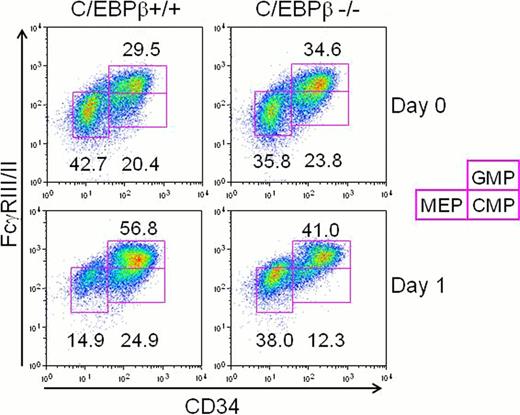Abstract
Abstract 2336
Granulopoiesis, the process of granulocyte production in the bone marrow (BM), is tightly regulated to meet host demands during both 'steady state' and 'emergency' situations such as infections. The transcription factor CCAAT/Enhancer Binding Protein β (C/EBPβ) plays critical roles in emergency granulopoiesis (Hirai et al. Nat Immunology, 2006). However, the precise developmental stages in which C/EBPβ is required are unknown. In this study, we investigated the roles of C/EBPβ in the proliferation and differentiation of prospectively identified intermediates between hematopoietic stem cells and mature granulocytes in mouse BM.
In order to analyze the mouse BM cells undergoing granulopoiesis, novel flow cytometric method was developed. Mouse BM cells retaining the ability to give rise to granulocytes were dissected into five distinct subpopulations (#1–#5) according to their levels of c-kit and Ly-6G expression. Upon infection of Candida albicans (4 × 106 CFU/20 g body weight/mouse) on day 1, C/EBPβ was upregulated at the protein level but not at mRNA level in all the granulopoietic subpopulations, suggesting the importance of the transcription factor in □emergency' granulopoiesis.
Then, the role of C/EBPβ was further assessed by analyzing C/EBPβ knockout (KO) mice. At steady state, the distribution of granulopoietic cells in BM of C/EBPβ KO mice at □esteady state' was identical to that of wild type (WT) mice. In contrast, the rapid increase in immature subpopulations #1 and #2 observed in WT mice at 1 day post-infection was significantly attenuated in C/EBPβ KO mice. The levels of mRNA expression for granule proteins (cathepsin G, myeloperoxidase, elastase 2, proteinase 3, lactoferrin and MMP9) within each subpopulation from WT and C/EBPβ KO mice were identical at both steady state and during infection. When the cell cycle status of these models was evaluated using in vivo BrdU labeling experiments, incorporation of BrdU in subpopulation #1 and #2 in C/EBPβ KO mice was always slightly lower than in WT mice, but the differences were not statistically significant. These findings suggest that C/EBPβ is required for efficient proliferation of early granulocytic precursors but not directly involved in the differentiation/maturation process.
To elucidate the roles of C/EBPβ in the proliferation of the early granulopoietic subpopulations, the hematopoietic stem cells (HSCs) and myeloid progenitor compartments were analyzed in WT and C/EBPβ KO mice. The frequency and number of c-kit+ Sca-1+ lineage markers− HSC were identical between WT mice and C/EBPβ KO mice during the steady state, and were not significantly affected on day 1 post-infection. Induction of candidemia increased the frequency and number of granulocyte-macrophage progenitors (GMP) in WT mice, and these increases were significantly attenuated in C/EBPβ KO mice. Upon induction of candidemia, the frequency of BrdU-positive cells in the HSC and common myeloid progenitors (CMP) populations from WT mice increased significantly; however, an increase of BrdU-positive cells was observed only within the HSC compartment in C/EBPβ KO mice, and at a lower level than that in WT mice
Taken together, these data suggest that the proliferation of early granulocytic precursors is tightly coupled to differentiation/maturation and that C/EBPβ is involved in the efficient amplification of early granulocyte precursors including HSC and myeloid progenitors during candidemia-induced 'emergency' granulopoiesis.
No relevant conflicts of interest to declare.
Author notes
Asterisk with author names denotes non-ASH members.


This feature is available to Subscribers Only
Sign In or Create an Account Close Modal